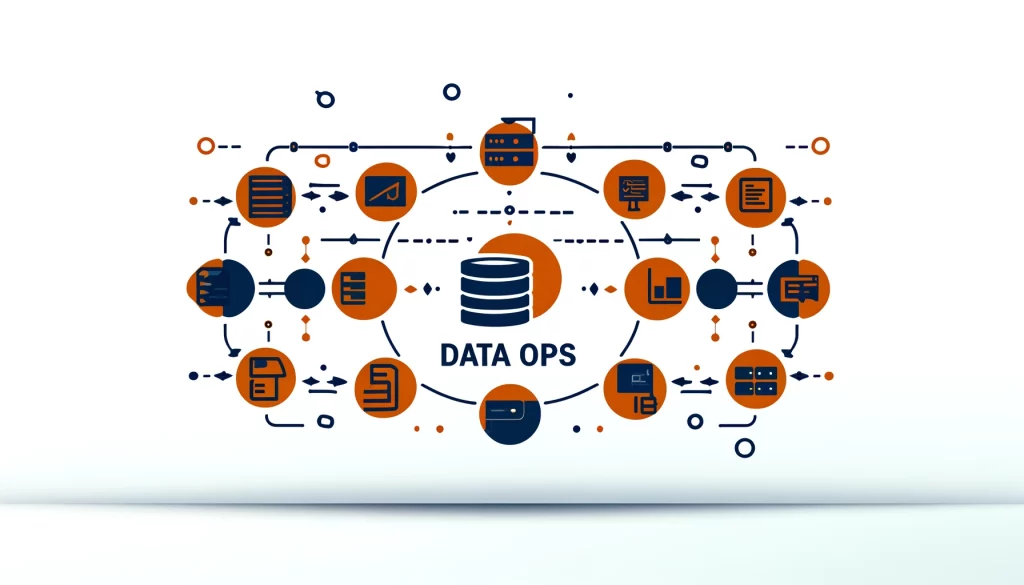
DataOps: Data Operations

Introducing DataOps
DataOps is a collaborative data management approach using people, processes, and technologies for rapid and reliable data delivery.
Obviously, data is crucial for organizations. Effective data management needs a comprehensive, collaborative approach.
DataOps enables organizations to maximize their data assets by promoting collaboration and automating data workflows. This includes managing data ingestion, transformation, analyzing, and visualization.
DataOps ensures correct, up-to-date data availability for all users, including scientists, analysts, and decision-makers.
The Rise of Data Operations
Several factors have contributed to the growing popularity of DataOps in recent years. As data drives more business decisions, efficient data management becomes more important.
Big data’s rapid growth has created new opportunities for organizations to leverage their data for a competitive edge. Artificial intelligence and machine learning have emerged, enabling organizations to make the most of these new opportunities.
Managing these huge and intricate data systems is challenging and demands a fresh management approach.
This is where DataOps provides a structure to optimize data processes, enhance data quality, and accelerate insights.
Companies can benefit from DataOps in various ways. One way is by improving data fluency. Another way is by promoting collaboration between teams.
DataOps can also speed up the time-to-market for data-driven products and services. Additionally, DataOps helps ensure better data quality and reliability.
The DataOps Methodology: A Closer Look
At the heart of DataOps lies a well-defined methodology that guides organizations through the process of data management. This methodology consists of three key stages: Sandbox, Staging, and Production.
In the Sandbox stage, data teams explore and experiment with data, identifying potential insights and use cases.
This is where data experts thoroughly analyze the data to uncover valuable insights for the business.
The Staging stage focuses on data cleaning, documentation, and modeling, gradually improving data quality and validating models for production.
This crucial step verifies that the insights from the Sandbox stage are correct, dependable, and ready for use. The final step deploys the validated data models, giving users precise data to drive decisions.
This is where the real work begins. The information collected through Data Operations assists produce concrete results for the business.
Companies can ensure data moves smoothly and efficiently using this method. This helps them get insights faster and make better decisions. The data moves from where it starts to whoever needs it.
Agile, DevOps, and Lean: The Pillars of Data Operations
DataOps draws inspiration from three effective approaches that transformed software creation and manufacturing: Agile, DevOps, and Lean.
Agile principles enable data teams to work iteratively, delivering value in short sprints and adapting to changing requirements. This approach makes sure data teams focus on the top priorities and can quickly shift directions when necessary.
DevOps methods like continuous integration and deployment automate and strengthen data pipelines. This cuts down errors and speeds up delivery times.
Meanwhile, Lean manufacturing ideas concentrate on cutting waste and streamlining processes for peak efficiency. This helps organizations get the maximum value from their data assets.
DataOps combines different methods to create a strong management framework. It focuses on working together, using automation, and always looking for ways to improve. This helps organizations stay competitive in a world that relies more and more on data.
DataOps vs. DevOps: Understanding the Difference
While DataOps and DevOps share some similarities, they are distinct approaches with different focuses. DevOps primarily deals with the integration of software development and IT operations, aiming to streamline the software delivery process.
It focuses on breaking down silos between development and operations teams, enabling faster and more reliable software releases. Data Operations, on the other hand, is specifically concerned with data workflows and the management of data pipelines.
The goal is to bring the flexibility, automation, and teamwork of DevOps to managing data, similar to how it improved software development. However, DataOps does borrow some principles from DevOps, such as version control, continuous integration, and continuous delivery.
By leveraging these practices, Data Ops enables data teams to work more efficiently and collaboratively, ultimately delivering higher-quality data to stakeholders.
DataOps and MLOps: Enabling AI and Machine Learning
Organizations are increasingly using AI and ML for innovation and competitive advantage. This has made efficient data management more important than ever. AI and ML models are only as good as the data they use for training.
This is where DataOps intersects with another emerging field: MLOps. MLOps is about managing the lifecycle of ML models. This includes development, training, deployment, and maintenance. It stands for Machine Learning Operations.
MLOps brings the same discipline and automation to managing machine learning models as DevOps did for software. Following DevOps methods ensures machine learning models use high-quality, dependable data.
Even tiny errors or inconsistencies in the data used to train machine learning models can cause big inaccuracies in the models’ outputs.
Together, DataOps and MLOps are a powerful combination that allows organizations to fully utilize AI and machine learning capabilities. This drives innovation and competitive advantages.
Overcoming Challenges with DataOps
Implementing DataOps is not without its challenges. One of the biggest hurdles organizations face is breaking down silos between data and development teams.
Data Operations require a cultural shift towards collaboration and communication, which can be difficult to achieve in organizations with entrenched departmental boundaries.
Data teams and development teams frequently use different terminology and have contrasting priorities, making it difficult to get on the same page.
Also, outdated systems and processes can slow down adopting DataOps, since they may not fit with the agile and automated workflows that DataOps uses.
Many organizations have invested heavily in traditional data management approaches and may be reluctant to change course.
However, by directly addressing these challenges and investing in the right tools and skills, organizations can successfully shift to a DataOps approach and gain advantages from better data management.
Best Practices for Successful Implementation
To successfully implement DataOps, organizations should follow a set of best practices. First, it’s important to establish clear goals and objectives for the DataOps initiative that fit with the overall business strategies.
This ensures DataOps efforts are focused on providing value to the company, not just using technology for technology’s sake.
Additionally, companies should invest in the right tools and technologies for DataOps workflows, like platforms to integrate data, tools to ensure data quality, and systems for version control.
These tools enable automation, collaboration, and continuous improvement, which are critical to the success of Data Operations. Training and improving team member skills is also key, as DataOps requires a diverse range of abilities in data engineering, data science, and software development.
To build a robust DataOps team, companies should invest in training programs and recruit individuals with diverse skill sets.
Finally, organizations should foster a culture of continuous improvement, regularly measuring and optimizing DataOps processes to drive ongoing value.
Only commitment to trying new things will lead to success. Therefore, you also need to constantly learn and improve. Additionally, you must be open to challenging the norm and adapting to change.
The Future of DataOps: Trends and Predictions
As data continues to grow in volume, variety, and velocity, the importance of DataOps will only continue to increase. In the coming years, we can expect to see several trends shaping the future of DataOps.
One trend that is becoming more popular is using cloud-based data platforms. These platforms offer scalability, flexibility, and cost-efficiency to support DataOps workflows.
Cloud platforms help organizations create new data environments easily. They can adjust resources as needed. Organizations can also collaborate across different locations and time zones.
One trend is the rise of self-service data analytics. This allows business users to access and analyze data on their own. They can do this without relying on IT or data teams.
DataOps will be crucial for enabling self-service analytics. It ensures data is properly managed, secure, and current, while giving users the tools and training to discover useful insights from the data.
Since AI and ML are becoming more common, Data Operations will become increasingly important. This is to ensure that these technologies use only high-quality, reliable data.
It is important to use DataOps practices to ensure accuracy and dependability of AI and ML models. These practices include keeping track of data versions, understanding the source of data, and managing data quality.
Real-World Examples of DataOps in Action
Let’s explore some real-world examples of organizations that have successfully implemented DataOps practices to understand its impact better.
One example is Netflix, which created a highly automated and scalable data pipeline that allows them to process and analyze huge amounts of data in real-time.
Netflix uses DataOps methods like data versioning, data tracking, and automated testing to keep their data accurate and dependable as they quickly expand.
Another example is Airbnb. They have created a system that helps their data experts easily find and study data from different places.
Airbnb uses DataOps to make data more available to teams, allowing them to make quicker decisions based on data. These practices include data cataloging, data discovery, and self-service analytics. DataOps helps Airbnb’s teams access data easily and make quicker decisions based on data.
These examples show how DataOps can help organizations use their data better and create value for their business.
The Role of Data Governance
DataOps is mainly focused on making data workflows more efficient and speeding up the time it takes to gain insights. However, it also plays a crucial role in maintaining data governance and compliance.
Data governance is when organizations create rules to protect the quality, security, and integrity of their data assets. These rules include policies, procedures, and standards. Organizations establish these rules to ensure that their data is reliable and secure.
Data governance is crucial in Data Operations to ensure proper management of data from ingestion to analyzing to archival.
This means making sure the data is accurate, safe, and kept for the right amount of time. It also involves following rules like GDPR and HIPAA.
Integrating data governance into DataOps workflows helps organizations maintain secure, compliant, accessible and actionable data.
Building a DataOps Culture
Implementing DataOps involves more than just using new tools and technologies. It also requires a change in organizational culture.
A Data Operations culture breaks down barriers between teams, encourages collaboration, and enables individuals to own data quality and governance.
This means leaders must prioritize data and invest in the right people, processes, and technologies to manage it effectively. Leaders need to prioritize data. They must invest in the right people, processes, and technologies. This will help them manage data effectively.
DataOps requires individuals to embrace new working methods, constantly improve their skills, and collaborate across teams.
Creating a DataOps culture fosters a common goal around data and analytics, fostering innovation and value generation.
DataOps and the Future of Work
As data becomes increasingly crucial for business success, the skills required to manage and analyze data are quickly changing.
DataOps requires professionals who can bridge data, technology, and business.
Data Operations is becoming more popular. This will lead to a greater need for these skills. This will also result in the development of new job opportunities and career paths. Organizations that invest in developing DataOps talent will be well-positioned to compete in the data-driven future.
Conclusion
DataOps is an approach that helps organizations effectively manage and utilize their data assets.
DataOps streamlines data workflows, enhances team collaboration, and delivers high-quality data.
Putting DataOps into practice demands changes in company culture and mindset, not just tools and technology.
Organizations must break down silos, foster collaboration and communication, and empower individuals to take ownership of data quality and governance.
To gain from data, businesses must build data management and analyzing skills, and grow DataOps talent.
Those who can effectively utilize data will succeed in the future, and DataOps is essential to achieving this.
